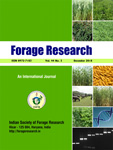RENU, ANIL KUMAR, RAJ SINGH AND MEHAK NAGORA
Department of Agricultural Meteorology, CCS HAU, Hisar-125 004 (Haryana), India
Department of Agronomy, CCS HAU, Hisar-125 004 (Haryana), India
*(e-mail: renuthurdak5454@gmail.com)
(Received: 10 July 2024; Accepted: 28 September 2024)
SUMMARY
The field study was conducted during Rabi 2019-20 at University Research farm of Department of Agricultural Meteorology, CCS HAU, Hisar. The two factor study comprised of four sowing dates as factor (A) namely (D1) -15th November, (D2) – 30th November, (D3) – 15th December and (D4) – 30th December, and four cultivars as factor (B) viz. (V1)- BH 393, (V2)-BH 902, (V3)- BH 946 and (V4)-BH 885. The experiment was laid out in factorial RBD design with three replications. The crop growth and phonological observations were found significantly highest in early crop sown on 1st fortnight of November (D1) that resulted in better overall growth and in terms of yield and yield contributing attributes and in variety BH 393(V1) that resulted in better overall grain and biological yield as compared to others. With respect to agrometeorological indices highest GDD, HTU, PTU were accumulated in crop sown on 2nd fortnight of December (D4) and in variety BH885 (V4) and highest TUE and RUE were found in crop sown on 1st fortnight of November (D1) and in variety highest TUE was found in BH 393 (V1) and highest RUE was found in BH 902 (V2) as compared to others.
Key words: Barley, GDD, RUE, PTU, growing environments and fortnight

